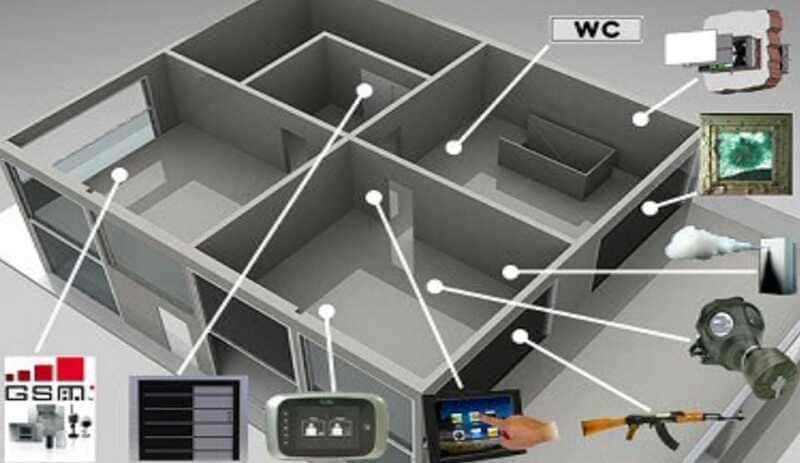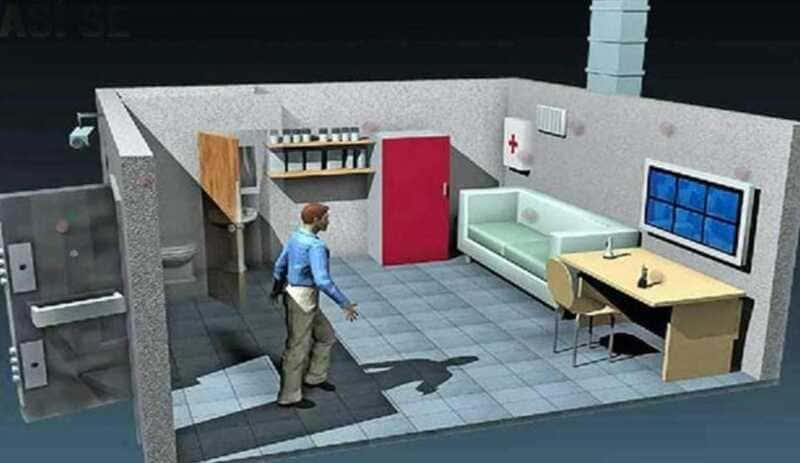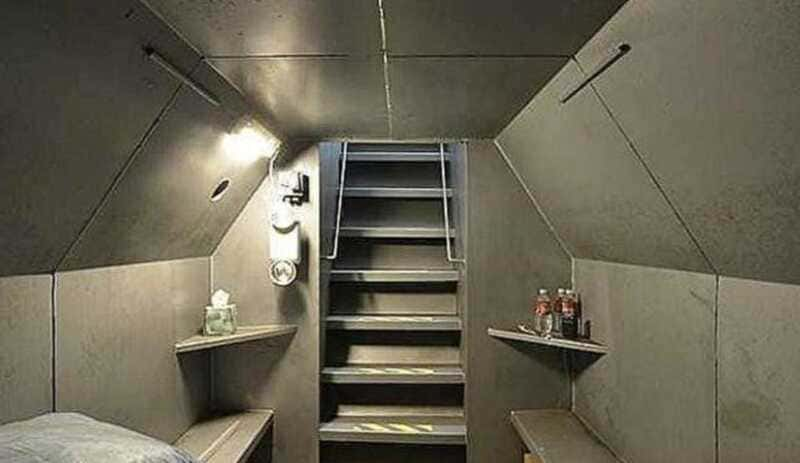In today’s world, where the security and tranquility of our homes can be threatened at any time, it is essential to have effective measures to protect our family and most precious assets. In this context, an increasingly popular and crucial solution has emerged: the panic room. Conceived as a safe and strategically designed space, this room offers refuge and protection from various emergency situations, providing the peace of mind needed to face moments of uncertainty.
Throughout this article, we will explore in depth the importance of a panic room in your home. From its historical origins to modern, sophisticated design options, we will address the key aspects that make this investment one of the wisest decisions in residential security.

We’ll discover how a panic room represents not only a physical barrier to potential threats, but also a psychological refuge that can make the difference between panic and calm in crisis situations. In addition, we will highlight the key elements that should be considered in its creation, from security features and technology to contingency planning.
Panic room concept.
In a world where security has become an increasingly pressing concern, the importance of a panic room in your home has taken on unprecedented relevance. The panic room, also known as a “safe haven” or “safe room,” is a space specially designed to provide protection and shelter in emergency situations.
The concept of the panic room dates back to the past, when wealthy individuals and prominent figures sought refuge during muggings or kidnappings. Today, however, this idea has evolved to suit the security needs of homes in different social strata.
The primary purpose of a panic room is to provide a safe place for occupants to turn to in the face of external threats such as burglary, intruders or imminent danger. This space, often strategically located in the home, is designed to resist attack and ensure the safety of those who take refuge inside.
Panic rooms are often equipped with advanced security technology, such as monitoring and communication systems that allow contact with the outside world and the ability to summon help in case of need. They also have specific physical features, such as reinforced doors and walls, high-security locks and, in some cases, emergency supplies to ensure survival for an extended period of time.
One of the most remarkable aspects of a panic room is its ability to provide psychological reassurance in times of crisis. Knowing that a safe haven is available within the home can reduce panic and stress, allowing people to face the situation with greater clarity and more rational decision making.
Design tips for an effective panic room.
The importance of a panic room in your home lies not only in its mere existence, but also in the careful planning of its design and location. When creating a space intended for safety and security, it is essential to consider several factors to ensure its effectiveness in emergency situations.
First, the design of the panic room should focus on discretion. It is critical that access to this safe haven be as discreet and concealed as possible to prevent potential intruders or external threats from easily discovering it. Designers and owners should carefully consider elements such as secret doors, hidden panels or even subway passages to keep the location completely confidential.
In addition, the space should have a comprehensive security system that provides effective protection. Doors and walls reinforced with resistant materials, high-security locks and advanced monitoring systems are crucial aspects that must be incorporated into the design. Having a communication system that allows contact with the outside for help is also essential in case of an emergency.

In terms of location, selecting the right place for the panic room is of utmost importance. Ideally, it should be located in an area that is easily accessible from the main areas of the house, such as bedrooms or living rooms. It is also recommended that it be close to the main entrances of the home, as this would facilitate quick access should the need arise.
In multi-story homes, consideration should be given to having a panic room on each level to ensure quick access no matter where the occupants are at the time of an emergency. In this way, the risks associated with prolonged travel in critical situations are minimized.
It is important to keep in mind that the design and location of a panic room may vary according to the specific needs and characteristics of each home. Therefore, it is advisable to consult security experts or professionals trained in the design of these spaces to obtain personalized advice and ensure that all security requirements are met.
Safety and security.
The importance of a panic room in your home is reflected in the meticulous attention that must be paid to the security features that comprise it. This fortified area is conceived as a bulwark of protection and safeguard against possible external threats, so it is crucial to have elements designed to ensure the integrity of the occupants.
First of all, one of the fundamental characteristics of a panic room is its robust construction. Walls and doors should be made of highly resistant and durable materials, capable of withstanding extreme forces and preventing the penetration of intruders or projectiles. It is suggested to use materials such as ballistic steel or reinforced concrete, which provide additional protection against physical attacks.
In addition, locks and access systems are vital to ensure the safety of those who take refuge in the panic room. High security locks, preferably electronic and with redundant locking mechanisms, should be used. Access to these locks should be limited to a few trusted individuals, which will reduce the possibility of intruders seeking access to the space.
Communication with the outside is also an essential aspect to ensure the effectiveness of the panic room. Two-way communication systems should be installed to allow contact with law enforcement, family members or other external points of contact. These systems may include telephones, intercoms or even radio communication systems.
Additionally, the panic room should have measures in place to ensure oxygen supply and the availability of food and water for extended periods of time. Having these basic resources in place can be crucial in crisis situations that last for a considerable period of time.
Also, the presence of internal and external monitoring systems is a highly recommended security aspect. Surveillance cameras allow constant control of the room’s surroundings, providing valuable information for decision making at critical moments.
The panic room can also be equipped with alarm systems that alert about emergency situations or intrusions. These alarms can be silent to avoid alerting intruders or loud to deter potential aggressors.
Types of threats.
A panic room becomes a bulwark of security and protection against a wide variety of threats and emergency situations that could jeopardize the integrity of those who live in a home. It is a shelter strategically designed to provide shelter in critical moments, offering the necessary tranquility to face diverse adverse circumstances.
One of the most common threats to which a panic room offers protection is the presence of intruders or assailants. In burglary or break-in situations, this fortified area becomes a safe place where occupants can turn to avoid contact with criminals and contact authorities for assistance.
In addition, the panic room is especially valuable in the event of a kidnapping or hostage situation. When personal safety is at risk, this shelter provides a safe space where hostages can remain protected until the authorities resolve the situation.
In the context of natural disasters, such as earthquakes or hurricanes, a well-designed and located panic room can offer protection from debris and dangerous elements. It can also be a safe space for shelter in the event of tornadoes, floods or other extreme weather events.
Another threat that a panic room can address is domestic violence. In situations where the safety of a household member is at risk due to aggressive or violent behavior, this space provides a safe haven where the victim can seek protection and escape the situation.
Likewise, in contexts of civil unrest or situations of generalized insecurity, the panic room can be a place of protection to avoid situations of direct confrontation with crowds or looters.
Equipment and supplies.
The effectiveness of a panic room lies not only in its design and strategic location, but also in the equipment and supplies stored inside. These essential elements are fundamental to ensure the survival and comfort of the occupants during an emergency, turning this space into a fully functional shelter.
One of the priority elements to take into account is the supply of drinking water. In emergency situations, it is essential to have water to stay hydrated and perform basic personal hygiene activities. It is recommended to store enough water bottles to cover the needs of all occupants for several days.

In addition, non-perishable food items are crucial to ensure the availability of a source of nutrition in the event of a prolonged emergency. Canned goods, energy bars, crackers and vacuum-packed foods are recommended options, as they do not require refrigeration and have a long shelf life.
First aid equipment is another critical piece of equipment in a panic room. A well-equipped first aid kit with bandages, gauze, antiseptics, basic medications and items to treat minor injuries is essential to provide basic medical care in case of injuries.
Lighting should include flashlights and flashlights with spare batteries. It is also advisable to have candles and matches or lighters as a backup, as they could prove useful in situations of prolonged power outage.
Communication equipment is another crucial component. It is suggested to include handheld or battery-powered radios, along with portable chargers to keep electronic devices working. Staying informed about the status of the emergency and external conditions is critical to making informed decisions.
In situations where ventilation may be a challenge, masks or air filters should be available to protect against fumes or contaminants in the environment.
Personal safety should also be considered, and it is advisable to have non-lethal defensive tools, such as pepper spray or personal alarms, to deter potential intruders or aggressors.
It is essential to periodically check and maintain the supplies stored in the panic room to ensure that they are in good condition and ready for use in the event of an emergency. It is also important to inform all occupants of the home about the existence and location of this safe area, and to provide them with the necessary instructions for its proper use.
Technology and communication.
In the current context, where connectivity and technology are fundamental in our daily lives, the importance of having communication and monitoring systems in a panic room is indisputable. These systems play a crucial role in maintaining contact with the outside world and requesting help in emergency situations, becoming a vital tool to ensure the safety and security of the occupants.
First and foremost, effective communication is essential to get assistance quickly. Equipping the panic room with two-way communication devices, such as cell phones, radios or intercoms, allows occupants to establish contact with family members, neighbors, emergency services or security forces to request help in case of need. These communication systems can be especially useful when the conventional telephone line is out of service or in situations of signal blockage.

In addition, modern technology offers advanced monitoring options, making it possible to maintain a clear view of the situation outside from inside the panic room. Surveillance cameras and video surveillance systems can provide real-time images, allowing occupants to assess the situation and make informed decisions about when it is safe to leave or when it is necessary to call for assistance.
The ability to maintain contact with the outside can also be vital to receive updates on the situation outside. In situations of natural disasters or large-scale emergencies, communication with outside sources can provide valuable information on the location of shelters, evacuation routes or the availability of nearby emergency services.
The implementation of communication and monitoring systems can also deter potential intruders or aggressors, as they know that the panic room is equipped to quickly summon help. This deterrence can be a determining factor in avoiding direct confrontational situations.
It is important to remember that technology and communication are tools that must be maintained and checked periodically to ensure their proper functioning in critical moments. Keeping the batteries of the devices charged, testing the communication systems and performing regular maintenance of the equipment are crucial aspects to ensure the effectiveness of these systems in emergency situations.
Some outstanding examples.
Over the years, there have been several real-life cases where a panic room has proven to be instrumental in protecting people and property in emergency situations. These outstanding examples highlight the importance of having a safe and strategically designed space to deal with threats and hazards.
One of the most well-known cases is that of businessman Jeff Greene, who in 2009 was in his Florida mansion when he was threatened by an approaching Category 4 hurricane. Thanks to his panic room, which featured fortified walls and doors, communication systems and emergency supplies, Greene and his family were able to stay safe during the devastating storm.
In another example, in 2002, a wealthy businessman named Leon G. Cooperman had a terrifying experience when two gunmen burst into his New Jersey home. Cooperman and his wife quickly took refuge in their panic room, which was discreetly hidden and equipped with a secret communication system. The intruders were unable to find them and were eventually apprehended by the authorities, while the couple remained safe in their safe haven.
We can also highlight the case of the famous fashion designer Oscar de la Renta, who had a panic room in his Connecticut home. Although it was never necessary to use it, he considered this space essential to ensure his and his family’s safety.
Another relevant example is that of journalist Anderson Cooper, who, concerned about his safety due to his work in dangerous areas of the world, installed a panic room in his residence in New York. This measure provided him with peace of mind and protection when he was at home and allowed him to concentrate on his work without fear of possible external threats.
These real-life cases demonstrate that a panic room is not just a luxury reserved for the wealthy, but a valuable option for any individual who values their safety and the safety of their loved ones. Proactive preparation and investment in this type of safe haven can make a significant difference in emergency situations, providing the peace of mind needed to face times of danger with calm and determination. These outstanding examples reinforce the importance of having a space designed specifically for personal protection, demonstrating that a well-implemented panic room can be an invaluable resource for ensuring safety in the most important place: our home.

